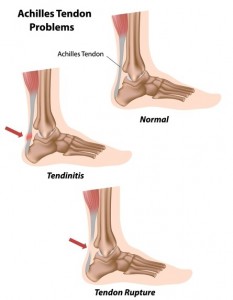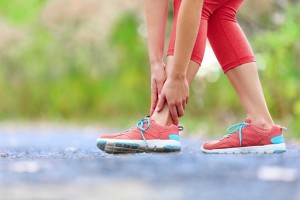Achilles Tendonitis
What is the Achilles tendon?
The Achilles tendon connects the muscles at the back of the calf (the gastrocnemius and the soleus) to the heel bone. As the largest tendon in the human body, it enables you to perform many everyday activities including walking, running and jumping. While it is very strong, it is susceptible to tendonitis when overused.
What is Achilles tendonitis?
 Achilles tendonitis, also referred to as Achilles tendinitis, occurs due to overuse or degeneration of the Achilles tendon. The pain associated with Achilles tendonitis is caused by inflammation.
Achilles tendonitis, also referred to as Achilles tendinitis, occurs due to overuse or degeneration of the Achilles tendon. The pain associated with Achilles tendonitis is caused by inflammation.
What causes Achilles tendonitis?
Most cases of Achilles tendonitis result from sports-related activities, specifically those involving jumping, running or sudden starts and stops. Unlike Achilles tendon ruptures, tendonitis isn’t caused by a one-time injury. Rather, it occurs gradually over time due to repeated stress on the tendon. Athletes who quickly increase activity level, such as the distance or duration of runs, without giving the body time to adjust are more prone to this injury. In addition, middle-aged individuals who participate in the same activity on an occasional basis, such as playing tennis on weekends, can be susceptible to the injury over time.
What are the types of Achilles tendonitis?
There are two types of Achilles tendonitis, depending on which part of the tendon is inflamed:
Noninsertional Achilles Tendonitis
Noninsertional Achilles tendonitis occurs in the middle of the tendon above the heel.
Insertional Achilles Tendonitis
Insertional Achilles tendonitis occurs at the bottom portion of the tendon where the tendon actually “inserts” or attaches to the heel bone.
What are the symptoms of Achilles tendonitis?
If you have Achilles tendonitis, you will likely experience:
- Mild to moderate pain in the back of the leg or above the heel
- Pain or stiffness in the morning (it may be worse the day after exercising)
- Swelling
- Tenderness
It is also possible that you will be able to see a physical thickening or hardening of the tendon from a side view. This often appears as a raised bump. With insertional tendonitis, affecting the area where the Achilles attaches to the heel bone, bone spurs (extra bone growths) are another potential symptom.
In the event that you experience a sudden popping or snapping sensation in your lower leg followed by sharp pain, there is a good chance you may have ruptured or torn your Achilles tendon and you should seek medical evaluation immediately.
What are the risk factors for Achilles tendonitis?
There are several factors that can increase your risk for Achilles tendonitis:
- Age – the Achilles tendon weakens with age,
 making middle-aged to senior athletes more prone to tendonitis
making middle-aged to senior athletes more prone to tendonitis - Sports involvement – participation in sports that involve running, jumping or quick starts and stops increase the chances of tendonitis (e.g. tennis, soccer, squash)
- Sudden increase in activity – a rapid increase in the amount of stress exerted on the Achilles tendon in sports or other activities puts you at a higher risk for injury
- Physical conditions – conditions including tight calf muscles, a flat arch, also known as flat foot, and obesity can all increase the pressure exerted on the Achilles tendon
- Worn out running shoes – shoes that are worn out cannot properly protect the Achilles tendon and absorb the pressure exerted when running
- Antibiotic medications– taking certain prescription drugs in the popular antibiotics class of fluoroquinolones (including ciprofloxacin and levofloxacin) increase the chances of tendonitis
What are the treatment options for Achilles tendonitis?
If you are experiencing pain, swelling or tenderness along the back of the lower leg, call our office at 212‑434‑4920 or fill out the schedule appointment form on this page so Stuart Katchis, M.D. can treat your injury as soon as possible.
Achilles tendonitis is fully treatable without surgery for most patients. Even in severe cases, conservative treatment options will be recommended first to gauge their effectiveness prior to considering surgical options.
Nonsurgical Treatment
Nonsurgical treatment options may take several months to fully take effect, depending on the course(s) of treatment taken and how long you were experiencing pain prior to seeking medical attention.
Nonsurgical treatment options may involve:
Resting
The first and most important step to recovery is stopping or reducing all activities that make the pain worse, particularly those high-impact activities that place considerable strain on the inflamed tendon.
Applying ice & elevating the leg
Applying ice to the injured area and elevating the leg will help reduce pain and swelling.
Taking anti-inflammatory medications
Taking over-the-counter anti-inflammatory medications can considerably reduce pain. If necessary, Dr. Katchis may prescribe a stronger medication to help with inflammation and pain.
Physical therapy
There are a number of stretches and strengthening exercises that can aid and sometimes even accelerate the recovery process. Dr. Katchis may recommend that patients see a physical therapist for treatment.
Using orthotics
Inserts placed in the shoes that elevate the heel can sometimes improve pain and assist the recovery process by taking pressure and strain off the injured tendon.
Wearing compression devices
Compression wraps or bandages can stabilize the injured tendon by reducing its movement. In addition, they may help reduce swelling.
Surgical Treatment
Surgical treatments include:
Gastrocnemius recession
Typically performed when a patient has difficulty flexing the foot despite regular stretching, this procedure lengthens one of the two gastrocnemius muscles in the calf to help relieve chronic Achilles tendonitis caused by tight calf muscles. The surgery involves Dr. Katchis making a small incision in the back of the leg through which he can view the muscle, either directly or via an endoscope, and then perform a release on the tendon. The muscle is then left to heal on its own or sutured to the underlying tissue in its new position.
Debridement and repair
Typically performed in cases where there is significant damage to the Achilles tendon, a debridement procedure involves the orthopedic surgeon resecting, or removing, the damaged portion of the tendon and then repairing the remaining tendon. In severe cases, the repair may involve transferring other tissue to reinforce it, called an Achilles tendon transfer.
Removal of bone spurs
With insertional tendonitis, surgery is often required to remove bone spurs as part of the Achilles tendon repair. In these cases, anchors may need to be inserted by the heel to secure the Achilles tendon in place.
What does the recovery process entail?
Recovery times will vary depending on the severity of each patient’s condition. Whether you undergo nonsurgical or surgical treatment for Achilles tendonitis, physical therapy is often an essential part of the recovery process. Physical therapy will help rebuild the strength of the injured tendon and the surrounding leg muscles. It is important to note that a weakened Achilles tendon is more susceptible to tearing so proper healing is especially important.




You must be logged in to post a comment.